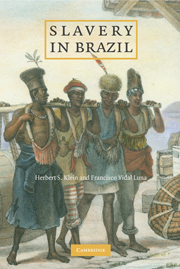Book contents
- Frontmatter
- Contents
- Preface
- I THE POLITICAL ECONOMY OF SLAVE LABOR
- 1 Origins of the African Slavery in Brazil
- 2 The Establishment of African Slavery in Brazil in the Sixteenth and Seventeenth Centuries
- 3 Slavery and the Economy in the Eighteenth Century
- 4 Slavery and the Economy in the Nineteenth Century
- 5 The Economics of Slavery
- II BRAZILIAN SLAVE SOCIETY
- III END OF SLAVERY
- Bibliography
- Index
1 - Origins of the African Slavery in Brazil
Published online by Cambridge University Press: 05 June 2012
- Frontmatter
- Contents
- Preface
- I THE POLITICAL ECONOMY OF SLAVE LABOR
- 1 Origins of the African Slavery in Brazil
- 2 The Establishment of African Slavery in Brazil in the Sixteenth and Seventeenth Centuries
- 3 Slavery and the Economy in the Eighteenth Century
- 4 Slavery and the Economy in the Nineteenth Century
- 5 The Economics of Slavery
- II BRAZILIAN SLAVE SOCIETY
- III END OF SLAVERY
- Bibliography
- Index
Summary
Slavery was well-known in most complex societies centuries before the establishment of the Brazilian colony by the Portuguese. Slaves were usually a small part of any labor force in most preindustrial societies and were most commonly tied to the household economy. In a few societies, they were used in agriculture, mining, or other productive enterprises beyond the household economy. No ethnic group escaped enslavement, and all societies treated their slaves as outsiders, rootless and ahistorical individuals ultimately held against their will by the threat of force. Because of their legal position, slaves were also the most mobile labor force available in any society.
In the work they performed and in their lack of control over their own lives, slaves were not unique from other subordinate members of their respective societies. Peasants were often in a temporary condition of servitude, some being tied to the land on a permanent basis. Children, women, and prisoners often lived lives indistinguishable from those of slaves in terms of the labor they performed or the rights immediately available to them. But it was the lack of ties to family, kin, and the community that finally distinguished slaves from all other workers. True slaves were persons without the bindings and linkages common to even the lowest free persons and who were thus completely dependent on the will of their masters. Masters could use their slaves at far less cost in reciprocal obligations than any other labor group in their societies.
- Type
- Chapter
- Information
- Slavery in Brazil , pp. 3 - 18Publisher: Cambridge University PressPrint publication year: 2009



